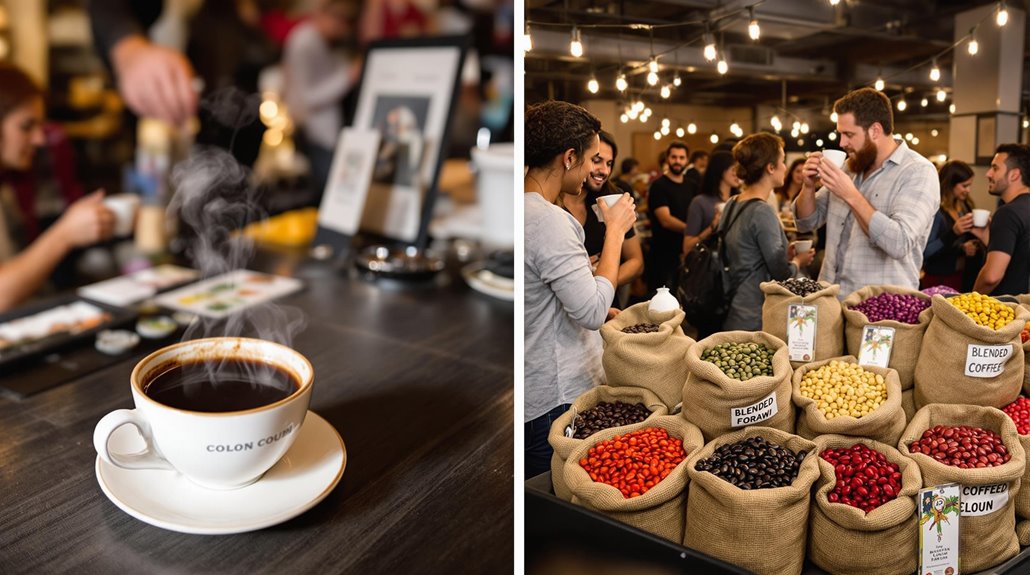






When it comes to coffee, you could say there are two distinct paths to explore. Single-origin coffee, sourced from a specific locale, offers a unique taste that reflects its environment, while blended coffee combines beans from various places to create a dependable flavor profile. Each option has its merits, appealing to different preferences and occasions. But how do these choices affect not just your palate but also the overall coffee experience? Understanding the nuances between them might change the way you enjoy your next cup.
Key Takeaways
- Single-origin coffee comes from a specific location, showcasing unique flavor profiles influenced by local growing conditions and terroir.
- Blended coffee combines beans from multiple origins to create consistent flavor profiles, ensuring a balanced taste experience throughout the year.
- Single-origin coffees offer complexity and vibrant notes, appealing to adventurous drinkers who often enjoy them black.
- Blends provide reliability and mask imperfections, making them ideal for daily consumption, especially with additives like milk and sugar.
- The choice between single-origin and blends reflects individual preferences for exploration versus consistency in coffee flavor experiences.
Overview of Coffee Types
When diving into the world of coffee, you'll quickly encounter two primary types: single-origin and blended coffee. Single-origin coffee is sourced from a specific location, like a single farm or region, granting it unique flavor profiles that reflect the local terroir, climate, and soil conditions. This means that each cup can tell a story, appealing to adventurous coffee drinkers who crave complexity and depth in their brew.
On the other hand, coffee blends combine beans from multiple origins, creating a balanced and consistent flavor profile. This approach often caters to a broader audience, as the resulting taste is typically approachable and predictable. While single-origin coffees can change in flavor each year due to seasonal harvesting, blends maintain a stable taste across batches, making them a favorite for those who prefer familiarity in their daily cup.
Both types of coffee serve distinct preferences within the specialty coffee sphere. Single-origin enthusiasts enjoy the thrill of exploring diverse flavor nuances, while blend aficionados appreciate the harmony and reliability found in every sip. Understanding these differences allows you to choose the coffee experience that suits your palate best.
Characteristics of Single-Origin Coffee

When you sip on single-origin coffee, you're experiencing a unique flavor profile that reflects its specific farm or region. This traceability not only enhances your connection to the coffee but also supports sustainable practices, as you can appreciate the journey from bean to cup. With each harvest offering a distinct tasting experience, single-origin coffee invites you to explore the rich nuances shaped by its environment.
Unique Flavor Profiles
Single-origin coffee offers a fascinating exploration of unique flavor profiles that reflect the specific characteristics of its origin. When you sip on these single origin coffees, you're tasting the impact of terroir—those geographical and environmental factors that shape the growing conditions. Each harvest showcases distinct flavor notes, influenced by variations in weather, soil quality, and agricultural practices, meaning your experience can differ dramatically from year to year.
Unlike blends, which combine beans from multiple sources to create a uniform taste, single-origin coffees celebrate individuality. You might encounter vibrant fruity and floral aromas, or perhaps deeper earthy and spicy tones, depending on where the beans were cultivated. This complexity invites you to savor the nuances of each cup, making the experience truly immersive.
Due to the meticulous care involved in sourcing and cultivating these coffee beans, single-origin varieties tend to be pricier than blends. However, the investment is well worth it as you uncover the rich tapestry of flavors that each unique origin has to offer. Embrace the journey of single-origin coffee, and let each cup transport you to its place of birth.
Traceability and Sustainability
The traceability of single-origin coffee enhances your coffee experience by connecting you directly to the source of your brew. When you choose single-origin, you're not just savoring unique flavors; you're engaging with a story that reflects the ethical farming practices and environmental factors at play in its cultivation. This clear provenance allows you to understand exactly where your coffee comes from, how it's processed, and the fair compensation farmers receive.
Moreover, this traceability promotes sustainability. By knowing the origins, you can support farms that prioritize responsible practices, ensuring that the land remains healthy and the communities thrive. The environmental factors, such as soil quality and climate, also play a vital role in shaping the coffee's distinct characteristics, making each cup a reflection of its unique terroir.
When you choose single-origin coffee, you're fostering a transparent supply chain that builds trust. You can genuinely appreciate how your coffee choices impact the environment and the lives of farmers, making each sip not just an indulgence, but a conscious act of sustainability. Embrace the journey from farm to cup, and enjoy the deeper connection that single-origin coffee provides.
Understanding Coffee Blends

When you explore coffee blends, you're embracing a world of consistent flavor profiles crafted from multiple beans sourced from diverse origins. These blends aim to deliver a balanced taste experience, harmonizing body, acidity, and flavor notes for an approachable cup. With the right expertise, a well-crafted blend can elevate your coffee ritual, making it both predictable and satisfying.
Consistent Flavor Profiles
Crafting a consistent flavor profile is one of the key benefits of coffee blends, which combine beans from various origins to create a harmonious taste experience. Unlike single-origin coffees that can vary markedly from batch to batch, blends are meticulously designed to maintain a reliable taste throughout the seasons. This consistency is essential, especially when individual beans may experience fluctuations in quality or flavor year after year.
The blending process aims for a balanced interplay of body, acidity, and unique flavor notes, making these coffees approachable for a diverse range of drinkers. Skilled roasters play a significant role in this process, ensuring that the complexity of flavors shines through without muddling the overall experience. This expertise is necessary for creating blends that retain their character, allowing you to enjoy the same delightful cup time and again.
Furthermore, the consistent flavor profiles of coffee blends lend themselves well to additives like milk and sugar, enhancing the overall drinking experience. Whether you prefer your coffee black or with a touch of sweetness, blends can accommodate your taste while providing that dependable, enjoyable flavor you crave.
Balanced Taste Experience
Achieving a balanced taste experience in coffee blends involves skillful selection and combination of beans from diverse origins. By blending beans, roasters can create a harmonious array of flavors, aromas, and textures that appeal to a wide range of coffee lovers. This careful crafting results in a flavor profile that offers depth and complexity, often surpassing that of single origins.
The blending process is designed to provide a consistent product, ensuring that each cup delivers a reliable taste, regardless of individual bean variations. This consistency is particularly essential for daily coffee drinkers who cherish familiarity in their morning brew. By selecting complementary beans, roasters can mask imperfections that might stand out in single-origin coffees, resulting in a fuller-bodied experience.
Moreover, popular blends like Blue Bottle's Giant Steps and Bella Donovan exemplify this balanced taste approach, with predictable flavor notes that provide comfort and satisfaction. These coffee blends not only maintain their integrity when sugar or cream is added but also invite exploration of flavors, making them a staple in the cups of coffee enthusiasts everywhere. Embrace the world of coffee blends, and discover the artistry behind a perfectly balanced taste experience.
Flavor Profiles Comparison

Exploring the flavor profiles of single-origin and blended coffees reveals distinct experiences that cater to different preferences. Single-origin coffees are unique, offering complex flavors that reflect their specific terroir, weather, and soil conditions. Each cup can present bold and vibrant tasting notes, often featuring fruity or floral hints that make them best enjoyed black. You might find that the flavor of these coffees varies considerably from year to year, adding an element of surprise to each brew.
In contrast, blended coffee provides a consistent taste by combining multiple beans from various origins. This approach smooths out harsh flavors and creates a harmonious profile that's approachable for daily consumption. Blends often showcase a more subdued flavor experience, making them ideal if you enjoy adding milk or sugar without losing the essence of the coffee. While single-origin coffees invite exploration, blended coffee offers a reliable companion for your everyday rituals. Ultimately, whether you lean toward the bold complexity of single-origin or the balanced consistency of blends, each type offers a unique coffee journey tailored to your palate.
The Importance of Coffee Traceability

While many people savor their coffee without considering its origins, the importance of coffee traceability can't be overstated. Coffee traceability allows you to track the journey of your beans from the farm to your cup, ensuring transparency in sourcing and processing methods. Origin coffees are often highlighted for their unique flavors, which directly stem from specific growing conditions, and knowing this context enhances your appreciation.
By promoting sustainability and ethical practices, coffee traceability encourages producers to uphold high standards. Detailed records reveal essential information, such as the specific farm, compensation paid to farmers, and even the climate and soil conditions. This level of accountability in the coffee supply chain fosters trust between you and the coffee roasters who select beans from different origins.
When you choose traceable coffee, you're not just enjoying a quality product; you're also supporting practices that prioritize environmental and social responsibility. This connection enriches your coffee experience, as you become more aware of how various factors influence the flavor profile of each cup. Ultimately, coffee traceability is about more than just taste—it's about the story behind your brew and the values it represents.
Brewing Techniques for Each Type

When it comes to brewing coffee, the techniques you choose can greatly enhance your experience, particularly with single-origin and blended varieties. For single-origin coffee, brewing methods like pour-over or French press are ideal. These methods allow you to extract the unique flavors and characteristics inherent to each origin. You'll want to pay attention to your grind size; a medium to coarse grind works best for these techniques. Use a brewing ratio of 1:15 for best flavor extraction, and maintain temperature control between 195°F and 205°F to fully enjoy the coffee's spectrum.
On the other hand, blends thrive with methods such as espresso or drip brewing. These techniques can create a balanced cup that harmonizes the flavors and masks any imperfections of individual beans. For blends, a finer grind size is preferred, especially for espresso, and a brewing ratio of around 1:16 helps maintain consistency across cups. While blends are generally more forgiving with temperature, it's still beneficial to control it for the best results. By understanding and applying these brewing techniques, you can elevate your coffee experience to new heights.
Consumer Preferences and Trends

Brewing techniques play a considerable role in shaping consumer preferences, reflecting a broader trend in the coffee market that embraces both single-origin and blended varieties. As you investigate this vibrant coffee culture, you'll find that many coffee drinkers are increasingly drawn to the unique flavors of single-origin coffees while still appreciating the consistency that coffee blends provide.
Recent trends show that blends remain a favorite for daily consumption, thanks to their balanced flavor profiles that harmonize beautifully with milk and cream. On the other hand, single-origin coffees attract specialty enthusiasts keen to explore the distinctive tasting experiences derived from specific regions and their unique terroir.
Your choice of brewing methods can greatly influence your experience. Many consumers opt for blends due to their forgiving brewing processes, allowing for a relaxed coffee-making experience. In contrast, single-origin coffees often require more precise techniques to fully showcase their unique flavors.
Ultimately, the rise of coffee culture has fostered a spirit of experimentation, encouraging you to explore various origins and blends to uncover your personal taste preferences. Embrace this journey, as there's a world of flavors waiting to be discovered.
Engaging With the Coffee Community

Engaging with the coffee community offers you a vibrant opportunity to connect with over 100,000 enthusiasts who share your passion for exploring the nuances between single-origin and blended coffees. By joining various online platforms, you'll stay informed about the latest types of coffee, including limited edition releases and special offers from roasters. Social media channels like Facebook and Instagram are invaluable for sharing insights and experiences, allowing you to dive deeper into the world of coffee.
As you participate in discussions, you'll enhance your understanding of flavors and brewing techniques that differentiate single-origin from coffee blends. This exchange of knowledge not only broadens your palate but also helps you discover new brands and flavors that resonate with your preferences. Most communities foster a safe space, ensuring privacy for all members, which encourages open dialogue and sharing.
Don't hesitate to share your tasting experiences; your insights can inspire others while you learn from their journeys. By engaging actively, you'll cultivate a richer coffee appreciation, making your exploration of this beloved beverage even more rewarding.
Disclosure: As an Amazon Associate, I earn from qualifying purchases.



